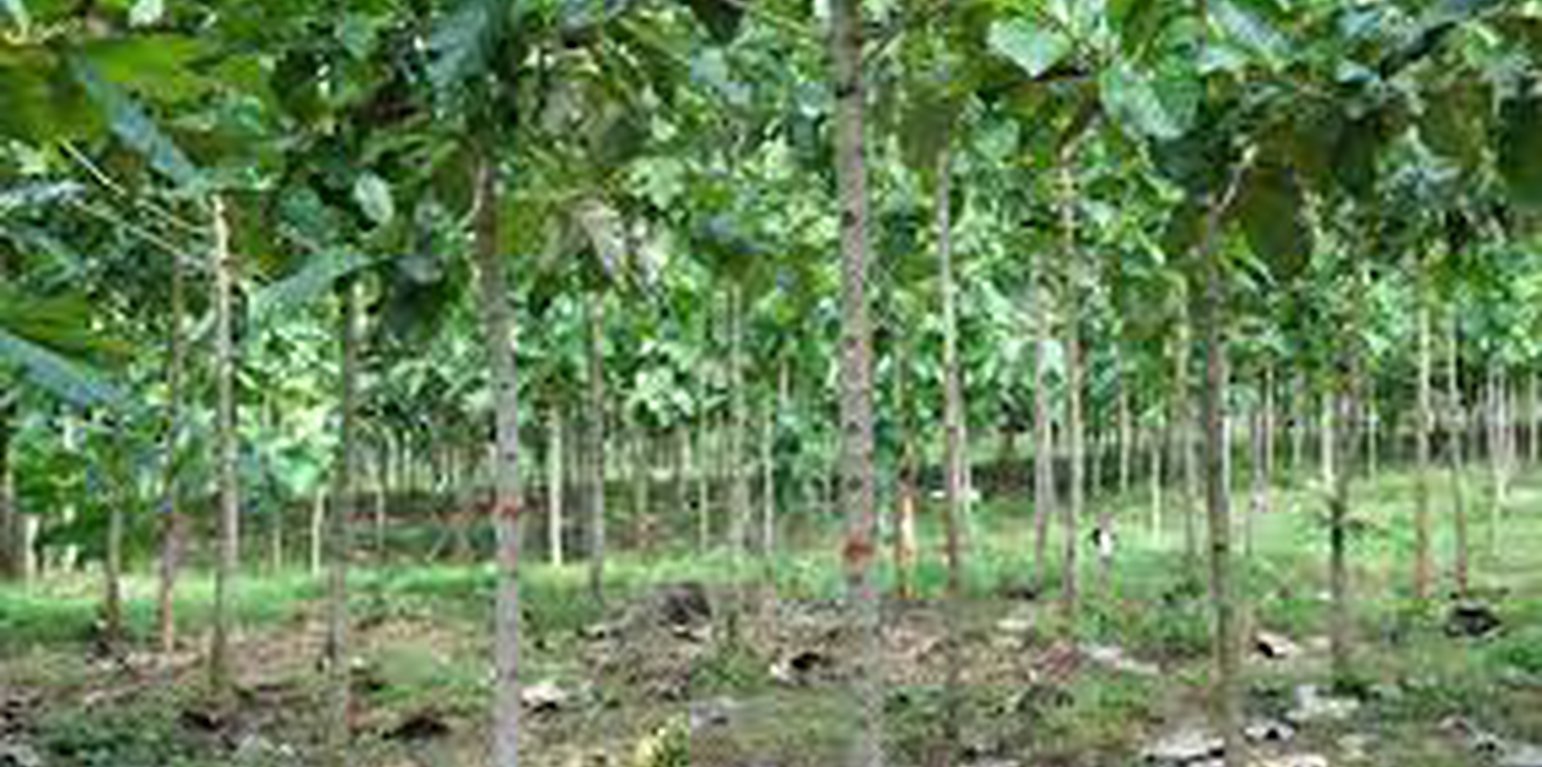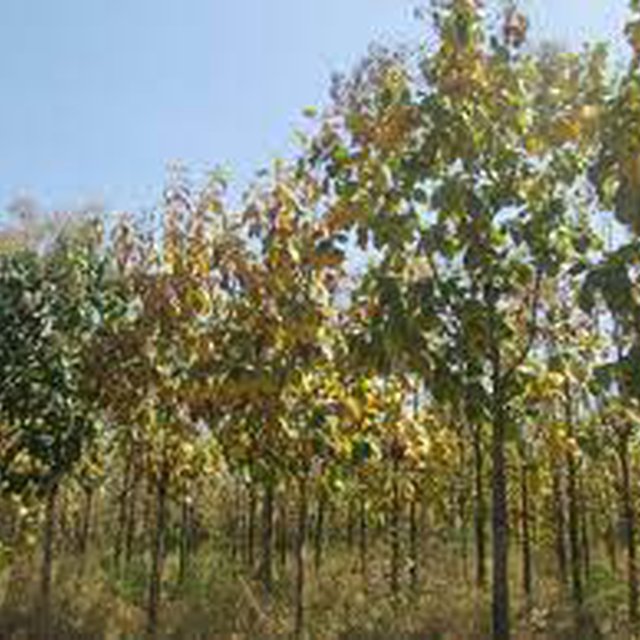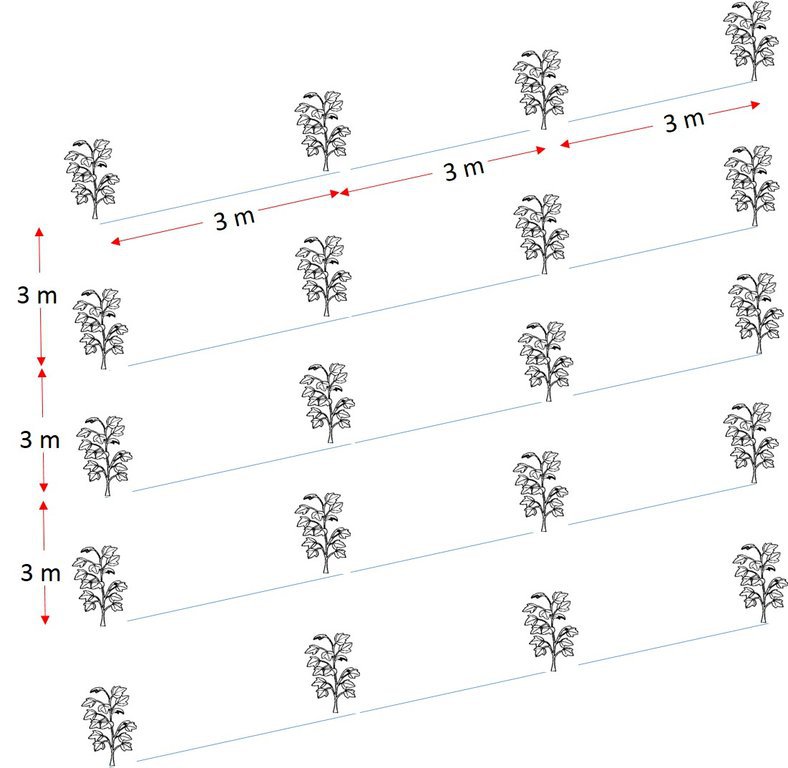



To establish this practice, the land-user puts into consideration the following: pitting at a depth of 3.5 inch, trees to be planted and spaced at 3 metres x 3 meters using the following inputs: tree seedlings, wheelbarrow, hoes, pangas and labour.
During the process, the tree stems are cut at 30cm length and planted. The stem is placed upright and later covered with soil. If there is adequate rain then some tip of the stem is left exposed but if rainfall is inadequate then the stem tip is covered in order for the plant to have enough moisture for its growth. It takes two weeks for the tip to get exposed on the surface when fully covered. The plant automatically appears with two leave lets.
The leaves when exposed to excessive sunlight can dry up and this retards its growth. This may require watering by the land user. At the early stage, the teak plantation can be inter cropped with beans and other crops such as sesame since the teak plantation has not yet formed a big canopy. This can be done for two years and later only slashing within the plantation needs to be done to maintain the plantation. The dry fallen leaves also kill weeds hence easing maintenance work. The trees are to be protected from fire outbreaks during dry season. In the month of November, fire lines are to be created and the dry leaves collected to mulch the plantation.
The cost of establishing a Teak plantations is high in the first 2-3 years but reduces significantly after first thinning. The cost of weeding can be reduced by spot-weeding of seedlings up to age 3 years, after which slashing or spraying with herbicides, usually Round-up is used for weed control. Wood from thinning is also sold as firewood or construction poles to recover some the establishment costs.
Shedding of teak leaves is heavy during the dry season and this causes a risk of fire. It’s advisable at this stage that the land user puts in place fire lines, an open space of 6 meters to separate the plantation into compartments in order to restrict fire from spreading from one part to another part.
Teak plantations are good at responding to dry conditions and can provide high-quality timber which in turn provides income. Teak trees provide hardwood timber, poles and modify the micro-climate through evapotranspiration. Fencing is done using bulb wires to avoid damage by wild animals and encroachments. The teak trees occupy land for a long period of time that can be used for other purposes like planting food crops. The piled dry teak leaves may harbour dangerous animals like snakes. Community members also complain about too much rainfall brought about by the plantation.
地点: Northern Uganda, 乌干达
分析的技术场所数量: 单一场所
技术传播: 均匀地分布在一个区域 (approx. < 0.1 平方千米(10 公顷))
实施日期: 2009
介绍类型






技术规范
作者:Betty Adoch
Teak is planted on a gently sloping natural environment with pitting done at a depth of 3.5 inch Trees are spaced at 3 metres x 3 meters using the following in puts: tree seedlings, wheel barrow hoe, pangas and labour.
|
|||||||||||
| 对投入进行具体说明 | 单位 | 数量 | 单位成本 (UGX) | 每项投入的总成本 (UGX) | 土地使用者承担的成本% |
| 劳动力 | |||||
| Hired labours | Manday | 30.0 | 3000.0 | 90000.0 | 100.0 |
| 设备 | |||||
| Ox-plough | pieces | 1.0 | 280000.0 | 280000.0 | 100.0 |
| Pangas | pieces | 15.0 | 10000.0 | 150000.0 | 100.0 |
| Axes | pieces | 7.0 | 15000.0 | 105000.0 | 100.0 |
| String for lining | bundle | 2.0 | 10000.0 | 20000.0 | 100.0 |
| 植物材料 | |||||
| Teak-seedlings | Stem | 6000.0 | 1000.0 | 6000000.0 | 100.0 |
| 技术建立所需总成本 | 6'645'000.0 | ||||
| 对投入进行具体说明 | 单位 | 数量 | 单位成本 (UGX) | 每项投入的总成本 (UGX) | 土地使用者承担的成本% |
| 劳动力 | |||||
| Plantation watchman | acres | 2.0 | 150000.0 | 300000.0 | 100.0 |
| Labour for fenching | acres | 8.0 | 100000.0 | 800000.0 | 100.0 |
| 设备 | |||||
| Poles for fenching | acres | 790.0 | 2000.0 | 1580000.0 | 100.0 |
| Bulb wires | bundle | 4.0 | 150000.0 | 600000.0 | 100.0 |
| Fellkin (for termites) | bottles | 5.0 | 7000.0 | 35000.0 | 100.0 |
| 技术维护所需总成本 | 3'315'000.0 | ||||
SLM之前的数量: low
SLM之后的数量: high
Fuel wood obtained from teak pruned branches
SLM之前的数量: low
SLM之后的数量: high
Shrub vegetation maintained with no cultivation taking place at the technology site
SLM之前的数量: Low
SLM之后的数量: High
Hard wood timber provided for construction purposes
SLM之前的数量: low
SLM之后的数量: high
Woodfuel provided from the pruned branches
SLM之前的数量: low
SLM之后的数量: high
From the sale of branches, poles and timbers sold to generate income
SLM之前的数量: low
SLM之后的数量: high
Income from poles and timber production other than only crop
SLM之前的数量: high
SLM之后的数量: low
Teak forests are easy to maintain since the dense canopy kills weed underneath
SLM之前的数量: low
SLM之后的数量: high
High water retention in the soil
SLM之前的数量: low
SLM之后的数量: high
SLM之前的数量: High
SLM之后的数量: low
Forest cover reduces the loss by binding the soil partials together
SLM之前的数量: low
SLM之后的数量: high
Dense vegetation cover
SLM之前的数量: low
SLM之后的数量: high
Teak plantation acts as carbon sink
SLM之前的数量: low
SLM之后的数量: high
Different plant species like grass, shrubs exist inside the forest
SLM之前的数量: Low
SLM之后的数量: high
Snakes, rabbits and other creators survive within the plantation
SLM之前的数量: low
SLM之后的数量: high
Improved trees variety fast maturing and drought resistant
SLM之前的数量: high
SLM之后的数量: low
Forest act as carbon sink
SLM之前的数量: high
SLM之后的数量: low
Trees acts as wind breaks
SLM之前的数量: low
SLM之后的数量: high
Forest modify the micro climate through evapotranspiration